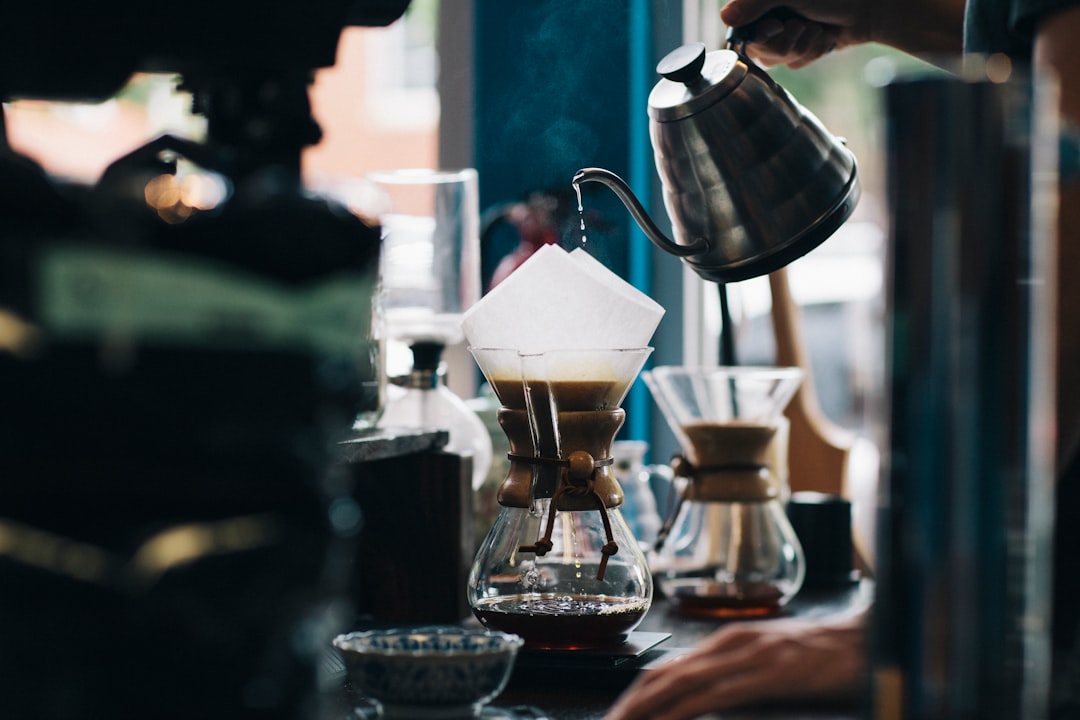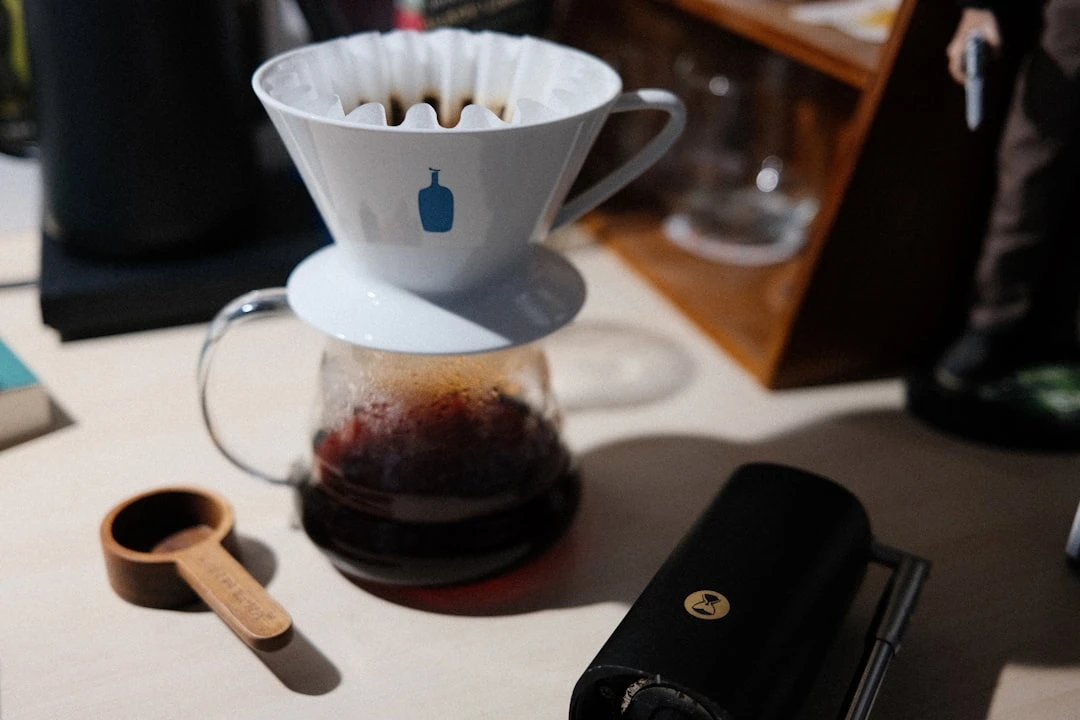The Perfect Chemex Grind Size: A Brewing Guide

Introduction to Chemex Brewing
That elegant glass hourglass sitting on your counter, promising a clean, bright cup with every pour. It’s simple, sure, but don’t let that fool you. That chunky paper filter? It’s like a bouncer at a club, tossing out oils and sludge so only the smooth, crisp flavors make it through. But here’s the kicker: screw up the grind, and suddenly that elegant brew turns into a sad, unbalanced mess.
Grind size?
It’s the puppet master behind the whole show. Too fine, and your coffee’s stewing in there, cranking out bitterness like a bad breakup. Too coarse? Water zips through like it’s late for a meeting, leaving you with a weak, sour letdown. For Chemex, you wanna hit that Goldilocks zone—medium-coarse, like sea salt sprinkled on your morning eggs. That’s the sweet spot where extraction dances between 3.5 and 4.5 minutes without choking the filter.
And here’s the sneaky part
Consistency. If your grinder’s having an off day, spitting out pebbles and dust in the same batch, your extraction’s all over the map. Some bits drown, others barely get wet—chaos in a cup. A solid burr grinder? That’s your wingman, keeping things steady.
But when you nail it? Oh, that’s when the Chemex sings. Those bright citrus notes, the whisper of florals, the deep chocolate hum—they all step into the spotlight. Dial it in, and every sip’s a little victory.
Understanding the Chemex Brewing Method
There’s something almost poetic about the Chemex—simple in form, but with this quiet precision that coaxes out the cleanest, brightest cup you’ll ever taste. Funny enough, it was dreamed up in 1941 by a chemist (of course), Dr. Peter Schlumbohm. That sleek hourglass shape isn’t just for looks—it’s part of the magic, along with those thick paper filters that strip away the harshness, leaving nothing but smooth, mellow sips behind.
But here’s the thing—Chemex isn’t your run-of-the-mill pour-over. Those filters? They slow everything down, letting the water take its sweet time as it dances through the grounds. No rushing, no bitterness—just coffee at its best. To nail it, you’ve gotta pay attention: water temp (somewhere between 195 and 205°F is the sweet spot), a steady pour, and—especially—that grind size.
Ah, the grind. Medium-coarse, like you’re sprinkling rough sea salt. Too fine? It’ll choke up and turn bitter. Too chunky? Well, then you’re basically drinking flavored water. Get it just right, though, and the water flows like it’s telling a story—layer by layer, flavor by flavor.
Once you really get the Chemex—the way it’s built, how those filters work, that perfect grind—you’ll see why coffee geeks swear by it. Tweak one little thing, and suddenly, it’s your coffee. And that? That’s the real magic.
Why Grind Size Matters for Chemex Coffee
Let’s talk grind size—because honestly, it’s the difference between a cup that sings and one that just kinda...whimpers. Those thick Chemex filters? They’re picky. Screw up the grind, and you’re either sipping on bitter tar or something so thin it tastes like coffee-flavored water. Not ideal.
You want a texture somewhere between sand and gravel—medium-coarse, but with a little personality. Think sea salt, not flour. That’s the magic zone where water moves through just slow enough to pull out all the good stuff without overstaying its welcome. And consistency? Non-negotiable. Uneven grinds turn your brew into a muddy mess, and that’s not why you bought a Chemex.
Here’s the thing: time and grind are tangled up. Too fine, and your coffee overstews, dragging out all the harsh, bitter notes. Too coarse, and it’s like the water’s in a sprint—no time to grab those bright, fruity flavors you’re after. The Chemex is built for clarity, so when you nail the grind, every sip’s crisp, clean, and balanced. No weird aftertastes crashing the party.
Oh, and if you’re still using a blade grinder? Bless your heart. A decent burr grinder’s worth the investment—it’s like giving your coffee a fighting chance. Get this right, and your Chemex turns into a ritual, not a gamble. Every. Single. Time.
Ideal Chemex Grind Size: A Detailed Breakdown
The Secret to Nailing Your Chemex Brew? It’s All in the Grind.
You ever pour yourself a cup from a Chemex and just… wow? That magic starts with the grind. Not too fine, not too chunky—medium-coarse, like the gritty sand under your toes at the beach. Get it wrong? Bitter sludge or watery disappointment. Get it right? Pure, smooth perfection.
Why This Grind Hits Different
Those thick Chemex filters don’t mess around. A fine grind turns your brew into a sluggish, over-extracted mess. Too coarse? The water zips through like it’s late for a meeting, leaving all the good stuff behind. But that sweet spot? 4-5 minutes for a full batch, and every sip sings.
How to Know You’re on Point
- Eyeball it: Think coarse sugar, not powdered. Definitely not pebbles.
- Timing’s everything: Draining too fast (<3:30)? Tighten it up. Taking forever (>5:30)? Loosen up.
- Trust your tongue: Sweet, bright, floral? Gold star. Sharp or dull? Tweak and try again.
Pro Move: Blade grinders? Eh, they’re like a wild card—unpredictable. Burr grinders keep it steady, no rogue chunks ruining your vibe.
Lock in that grind, and the Chemex becomes your best coffee buddy. Especially for those fancy single-origin beans or light roasts—every note, every whisper of flavor comes through like a mic drop.
Comparing Chemex Grind Size to Other Brew Methods
And with a Chemex, it's a whole different game—coarse, like gravel underfoot. Most methods don't go there. But that's the thing—it flips the entire flavor on its head.
For a Chemex, picture chunky sea salt between your fingers. Those thick filters? They're like bouncers at a club, tossing out the fines before they wreck the party. Too fine, and suddenly you're sipping on bitter, sluggish disappointment.
But your basic drip machine? Middle of the road. A touch finer than Chemex, but not by much. Quick brew, flimsy filter—no room for over-extracted nastiness. French press, though? Coarse, coarse, coarse. That metal mesh lets everything through, and the coffee's just stewing in there. Go fine, and it's like drinking the bottom of a pond.
Then there's espresso—dust-fine, because nine bars of pressure won't push through anything less. Aeropress? It's the wild card—medium-fine, balancing a quick steep with a little elbow grease.
Point is, grind size is your flavor remote. Chemex? Bright and crisp. Espresso? A knockout punch. Tinker all you want, but don't let bitterness or weak tea sneak in.
How to Adjust Your Grinder for the Perfect Chemex Grind
That’s where the magic happens. It’s the secret behind that crisp, almost tea-like clarity in your cup. Those thick filters don’t mess around—they’ll choke on fines if you let them. So you’ve gotta find that sweet spot: not quite French press chunky, but not drip-fine either. More like... beach sand with a few tiny pebbles mixed in.
First, don’t overthink it. Set your burr grinder somewhere in the middle (you are using a burr grinder, right?) and take a peek. Grab a pinch—should feel like rough salt between your fingers. If it looks like flour, back it off. Boulders? Crank it down a notch.
Now brew a test batch. Sip it.
- Too bitter? Like someone shoved a handful of dark chocolate into your throat? Grind’s too fine. Loosen it up.
- Weak and sad? Like dishwater with a hint of coffee regret? Go finer.
Timing’s your friend here. A good Chemex should take its sweet time—4 to 5 minutes, like a leisurely stroll. If it’s gushing through in 3, your grind’s basically gravel. If it’s dragging past 6, you’ve crossed into espresso territory.
And yeah, your grinder’s gotta play ball. Blade grinders? They’re like throwing beans into a tornado—uneven chaos. Burr’s the move if you can manage it.
Oh, and don’t forget—beans change the game. Fresh ones might need a hair coarser; stale ones could use a little extra fineness to wake ‘em up.
Pro tip: Scribble your wins in a notebook. “Burr setting 24, 4:30 brew, tasted like sunshine.” Next time? You’ll nail it faster. After a few rounds, you’ll just know. That’s when the Chemex sings.
Common Mistakes with Chemex Grind Size (And How to Fix Them)
Ah, the Chemex—elegant, fussy, and downright magical when you nail it. But that grind size? It's sneaky. One wrong move and suddenly your coffee's bitter, watery, or just... sad. Here's where most of us trip up—and how to pull it back from the brink.
1. The Dust Problem
You ever grind so fine it's basically powder? Yeah, that's a trap. The filter gums up, your brew drags on forever, and what's left in your cup tastes like regret. If your timer's pushing past 5 minutes, take the hint.
Fix: Aim for something like rough sand—not sugar, not gravel. Crank your grinder a notch coarser and watch the flow. Should feel steady, not sluggish.
2. Chunky Isn't Better
On the flip side, if your grounds could double as gravel, your coffee's gonna taste like weak tea. Brew's done in under 3 minutes? That's your sign.
Fix: Nudge it finer. The sweet spot's around 4 to 5 minutes—enough time to pull out all the good stuff without rushing.
3. The Uneven Mess
Blade grinders are like roulette—you get a little dust, a few boulders, and a whole lot of chaos. Some sips bitter, some sour. Not ideal.
Fix: A burr grinder's the dream, but if you're stuck with a blade, give it a shake mid-grind. Or heck, sift out the fines if you're feeling extra.
4. Stale = Doomed
Pre-ground coffee? It's already lost half its soul by the time you brew. No grind size can save it.
Fix: Fresh beans, ground right before. Trust me, it's a game-changer.
Dodge these pitfalls, tweak as you go, and that Chemex'll sing. Or at least stop hissing at you.
Testing and Fine-Tuning
You know that moment when you take that first sip and everything just clicks? That’s what we’re chasing here. But those thick Chemex filters—they’re like the bouncers of the coffee world, slowing everything down. So you gotta play nice with a grind that’s somewhere between beach sand and kosher salt. Sounds vague? Yeah, because it kinda is. But that’s where the fun begins.
Start Somewhere, Anywhere
Grab that bag of beans and set your grinder to medium-coarse (if you’re using a Baratza, think 20-22). Dump in a 1:16 ratio, pour slow, and watch the clock. Four to five minutes later, you’ll either be nodding approvingly or staring at your Chemex like it betrayed you. Too quick? Grind’s got more holes than Swiss cheese. Too slow? Mud.
Listen to Your Coffee
- If it tastes like someone waved a coffee bean near hot water, go finer.
- If it’s bitter enough to make you wince, ease up a click.
- But if it’s smooth, bright, and makes you want to text a friend about it? That’s your grind.
The Devil’s in the (Tiny) Details
A burr grinder’s your best friend here—consistency is key. And don’t go wild with adjustments. We’re talking micro moves. Maybe even jot down what works (or just trust your future self to remember… good luck with that).
One Last Thing
Stale beans? They’ll make you work harder—might need to crank the grind a touch finer. But fresh beans? They’re like that friend who shows up with good vibes and no drama.
It’s a dance, really. A little trial, a little error, and suddenly—there it is. That perfect cup. Clean, lively, and just right.
Best Coffee Beans for Chemex Based on Grind Size
You could have the fanciest Chemex setup, but if your beans don’t play nice with a medium-coarse grind, well—what’s the point? That chunky, sea-salt texture needs beans that won’t disappear or turn muddy. So let’s talk flavor.
Bright & Zesty: Light Roasts
Ethiopian Yirgacheffe, Kenyan AA—these are the beans that sing in a Chemex. They’ve got that floral, citrusy sparkle, and when you grind ‘em just right (not too fine, not too boulder-y), the thick paper filter lets all those delicate highs shine through. No hiding here.
Smooth & Balanced: Medium Roasts
Maybe you want something a little more… grounded. Colombian, Costa Rican, even a good Brazilian—these bring cocoa, toasted nuts, a roundness that holds up even if your grind wanders into "accidentally chunky" territory. Less fussy, still delicious.
The Safe Bet: Blends Made for Pour-Over
Look, some mornings you’re not dialing in your grinder with a microscope. That’s when a solid light-medium blend (like Blue Bottle’s Three Africas) saves you. If the bag says "filter" or "pour-over," it’s basically prepped to forgive your half-awake grinding.
Avoid Like Stale Beans:
Dark roasts ground coarse? Bitter. Fine grinds in a Chemex? Clogged filter sadness. Stick to the sweet spot—literally.
Pro move? Buy whole beans, grind fresh, and keep it medium-coarse. That’s the Chemex magic: clarity without weakness, body without sludge. Get this combo right, and every sip’s a reminder why you bother with the whole ritual.
Tools and Grinders
You know that moment when you take that first sip of Chemex coffee? The one that’s light, bright, and just right? It all starts with the grind. Not too fine, not too chunky—something like sea salt, with a little texture. Mess that up, and your brew can tip into bitterness or end up weak and underwhelming. But get it dialed in? Magic.
Here’s what’ll help you nail it:
Burr Grinders (Because Blades Just Won’t Do)
Skip the whirring blade chaos—burr grinders are the way to go. They’re the difference between a haphazard chop and a smooth, even texture. A few favorites?
- The Baratza Encore—reliable, affordable, and gets the job done without fuss.
- Fellow Ode Gen 2—basically built for pour-over lovers, with flat burrs that keep every grind uniform.
- 1ZPresso JX-Pro—if you’re up for a little arm workout, this manual grinder’s precision is chef’s kiss.
A Scale & Timer (No Guesswork Allowed)
Winging it leads to heartbreak. A solid scale (like the Hario V60) keeps your coffee-to-water ratio honest, and a timer? Non-negotiable. Aim for that 3:30–4:30 sweet spot—any longer and you’re flirting with over-extraction.
The Gooseneck Kettle (Pour Like a Pro)
A steady, controlled pour is everything. The Fellow Stagg EKG? Worth every penny with its temp control and that perfect, slow-flow spout.
And Don’t Skimp on the Filters
Chemex’s bonded filters aren’t just hype—they shape the brew’s flow and clarity. Knockoffs just don’t hit the same.
Put it all together—the grinder, the scale, the kettle—and suddenly, that dreamy, clean cup isn’t just possible. It’s yours.
Conclusion: Mastering Chemex Grind Size for the Perfect Cup
You know that moment when your Chemex coffee just clicks? That crisp, vibrant flavor—where every note sings? It all starts with the grind. Those hefty filters demand something coarser, like rough sand or sea salt, to keep the brew flowing smooth. Too fine, and you’re stuck with bitter sludge. Too coarse? Well, that’s just sad, weak tea pretending to be coffee.
Play around with it. Medium-coarse is your starting line. Taste a little flat or sour? Nudge it finer. Bitterness creeping in? Back off a notch. And if your grinder’s got burrs, even better—consistency’s the secret handshake here.
Yeah, water temp and pour technique matter, but the grind? That’s your foundation. Nail it, and those bright, fruity whispers in your beans finally get to shout.
Truth is, perfection’s personal—your beans, your roast, your taste buds. Tweak, taste, repeat. Before you know it, you’ll be chasing that just-right cup every morning. Cheers to the hunt.


